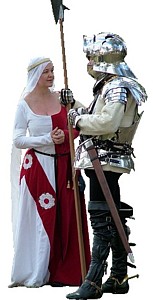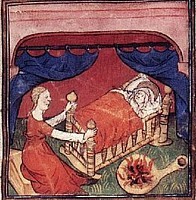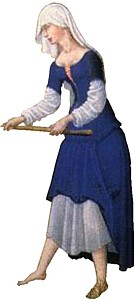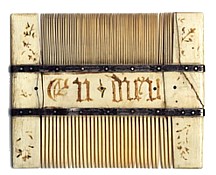|

a
woman's
life
births
weddings
divorces
death
& dying
manners
cooking
housework
shopping
gardening
livestock &
poultry care
education
employment
opportunities
recreation
& hobbies
holidays
&
feast days
board
games
music
embroidery
& needlework
pet
keeping
reading
dancing
horseriding
hawking
hunting
sex &
sexual health
PLEASE NOTE!
ADULT THEMES!
|

Manners
For The Well-bred Medieval Woman
MANNERS - ETIQUETTE - CONVERSDATION - DEPORTMENT
- DRESSING APPROPRIATELY
ACCEPTING GIFTS - TABLE MANNERS - RULES FOR THE TABLE
Medieval manners
 Manners
were a very important part of a medieval woman's life. The common
misconception of a rough and rude society with little polish is
a widely-mistaken belief. Manners
were a very important part of a medieval woman's life. The common
misconception of a rough and rude society with little polish is
a widely-mistaken belief.
It is true that medieval life could be violent and dangerous,
but people from all walks of life were bound to adhere to a certain
amount of daily courtesy. To fail to do so was social peril and
could cost a person their life for an insult, whether real or
perceived, against a person of higher social standing.
The late medieval poem, How
The Good Wife Taught Her Daughter gives motherly advice for
general deportment in public:
And when thou goest
on thy way,
Go thou not too fast,
Brandish not with thy head,
Nor with thy shoulders cast,
Have not too many words,
From swearing keep aloof.
For all such manners
Come to an evil proof.

Social
etiquette for the well-bred woman
Social standing and ones place in society was everything
in the medieval world. One might hope to advance through material
gains, but had little hope to do so without the correct courtesy
and manners.
Guibert de Nogent, c. 1055
– 1124) was a 12th century Benedictine who write extensively
on history and theology. He wrote about the decline in good manners
in women i his society:
"Alas, how miserably...
maidenly modesty and honour have fallen off, and the mother's
guardianship hath decayed both in appearance and fact, so that
in all their behavious nothing can be noted but unseemly mirth,
wherin are no sounds but of jest, with winking eyes, and babbling
tongues, and wanton gait, and most ridiculous manners.
The quality of their
garments is so unlike to the frugality of the past that in the
widening of their sleeves, the tightening of their bodiecs,
their shoes of cordovan morocco with twisted beaks- nay, in
their whole person, we may see how shame is cast aside."
A woman was always expected
to be the epitome of good manners no matter what her status in
life and the higher a woman was born, the more essential it was
for her to act appropriately.

Conversation
and speech
Manners which were appropriate for a man were not always appropriate
for a woman. Indeed, it was completely unseemly that a woman swear
for any reason whatsoever. Common women might, but it wasn't good
breeding. It would bring great shame upon her father or husband.
The medieval writer, Robert of Blois, admitted that ladies needed
to know how to behave, but that it was difficult for women-
"If she speaks,
someone says it is too much. If she is silent, she is reproached
for not knowing how to greet people. If she is friendly and
courteous, someone pretends it is for love. If on the other
hand, she does not put on a bright face, she passes for being
too proud."
A woman who entered a conversation
with a stranger might gain herself a bad reputation for being
too free and easy with stranger men and to accept a kiss from
a male friend or acquaintance or from a man who is not related
by blood or marriage, even on the cheek, would have had tongues
wagging and ruined a woman's reputation.
 In
the middle ages, a woman's reputation was everything. Should there
be any kind of a legal dispute, or she be a witness in a counrt
case, her good moral reputation would assist in her being taken
seriously, not an easy task at best. In cases of sexual assault,
a spotless character was more likely (but not always) to get a
prosecution. In
the middle ages, a woman's reputation was everything. Should there
be any kind of a legal dispute, or she be a witness in a counrt
case, her good moral reputation would assist in her being taken
seriously, not an easy task at best. In cases of sexual assault,
a spotless character was more likely (but not always) to get a
prosecution.
When it came to chatting
with others, one should never address a social superior first,
especially if one was a woman, and an appropriate greeting must
be given. It was considered the height of rudeness to avert your
gaze to a man or woman who ranked higher than oneself. Honesty
was judged by the directness in the eyes and to hide ones face
was interpreted as dishonesty and ill-intent.
It was also incredibly rude for a woman to turn her back on a
social superior. She should wait for the person to pass or have
removed herself from the room backwards.
When introducing a person,
should there have been no man to do it for her, convention dictated
that a woman must introduce the highest rank to the lowest and
then vice versa. This is still true for introductions today.
An error in the order of introduction could have been a grave
insult indeed. Should a woman have found herself in the company
of important people and another important one arrive, she must
bow and move away to permit the newcomer the privilege of standing
closer.
When a woman entered the house or room of a person of equal standing,
a woman ought bow just a little to acknowledge the arrival. If
of higher standing, she ought kneel on the right knee. Should
she have been presented to the Queen, she knelt at the door, entered
only halfway and knelt again. Only if she was motioned further
might she have gone closer.
It was always better to err on the side of caution in this regard
as it was better to appear humble and meek than ill-mannered and
rude.

Deportment
Women were instructed to be gracious in their deporture and not
wriggle their shoulders, looking straight ahead with a tranquil
and measured air. When out in society, is was important that a
woman's hands not be touched by a man who is not of her family.
Public displays of affection in the form of hand-holding was quite
inappropriate.
Robert de Blois also wrote that
"Ladies should
walk erect, with dignity, neither trotting nor running, nor
dallying either, with their eyes fixed on the ground ahead
of them. They were to be particularly careful that they do
not regard men as the sparrowhawk does the lark."
When traveling outside the home, it was acceptable for any woman
to walk arm in arm with her female companion or a male member
of her family. A woman of good breeding did not venture out alone.
A working woman or a mother in a small peasant household may have
cause to go out alone, but only when unavoidable. Where possible,
she would send a son on an errand on her behalf or seek the security
of another woman's company when going to the bakehouse or to the
creek for washing. There's safety in numbers, and numerous court
cases exist where women were molested whilst out doing daily chores
in lonely places. Or at home. Or on the roads.

 Dressing
appropriately Dressing
appropriately
Hair was almost certainly to be covered in one of the latest fashions
outside the house. For a great deal of the medieval period, to
go out with a bare head when one was not a child, could have a
woman marked as a prostitute or a women of dubious morals. In
Italy, this fashion was abandoned earlier than England and other
parts of Europe as Italians embraced elaborate braided hairstyles.
Unless one was a washerwoman or a engaged in manual labour, arms
were never bare.  If
a gown with wide sleeves was worn, then another with close fitted
sleeves was worn under it to cover the arms. If
a gown with wide sleeves was worn, then another with close fitted
sleeves was worn under it to cover the arms.
Chemise sleeves were never
seen in public. Only if the pin-on sleeves had been removed for
manual tasks might they be visible, but a women never left the
house or would recieve company without first covering her underwear.
The exception might be farm workers with short-sleeved kirtles
on a hot summer's day, as seen in the image at the right, from
the Tres Huers du Duk du Berry, early 15th century.
At certain times, the fashion for lower cut gowns were popular.
Of course, one who wore her dress too low-cut was again marked
for comment and gossip. It was assertained that a woman's neckline
may be low, as low as her armpits, but no lower.
Until the renaissance and Italian fashions took hold, the chemise
or smock was an undergarment, meaning that it shouldn't be seen
at all, except as we have previously mentioned. A good general
rule of thumb was that the under layer was covered by the next:
the chemise was covered by the kirtle, the kirtle by the surcote.
One would not expect to find a visible chemise under a kirtle
neckline or a kirtle neckline under a surcote.

Accepting
gifts from men
The Medieval Art of Love by Michael Camille tells us a
little about love's gifts, what may and may not be freely given
to a lady without being inappropriate.
 He
tells us of a text by Andreas Capellanus which states- He
tells us of a text by Andreas Capellanus which states-
"A lover may freely
accept from her beloved these things- a handkerchief, a hairband,
a circlet of gold or silver, a brooch for the breast, a mirror,
a belt, a purse, a lace for clothes, a comb, cuffs, gloves,
a ring, a little box of scent, a portrait, toiletries, little
vases, trays, a standard as a keepsake of the lover, and so
to speak more generally, a woman may accept from her love whatever
gift may be useful in the care of her person, or may look charming,
or may remind her of her lover, providing, however, that in
accepting the gift it is clear that she is acting quite without
avarice."
This also gives us an insight
into what kinds of items were freely available at that time.

 Medieval
Table Manners Medieval
Table Manners
Medieval people were very religious and prayer was an integral
part of the day. A prayer would certainly always be said before
any meal even when eating at home.
Hands were always washed both before and after a meal. Even people
with little in the way of tableware were conscious of basic hygiene
and good manners. Mothers have, after all, changed very little
over the course of time and always sought to instill the best
manners she can in her offspring. There is little hope of social
improvement with no manners and should one be called upon to serve
a person of higher rank, and it was imperative that offense not
be given, even unintentionally.
A feast would begin by less important people washing their hands
before going to the table. To fail to do so was the height of
rudeness. The upper class and guests of honour would be seated
by a servant. A washing bowl would be delivered to them at the
high table.
The chaplain would say a prayer before any of the food is brought
to the tables. Communal plates were usual and meant to serve four
people at once. The guests at the high table, however, only had
to share with one other person.
 The
image at right shows a scene from the Duk du Berry's Tres Riches
Heures, illuminated 1412-1416. Food and fine clothing show
a standard of living above the average man. The
image at right shows a scene from the Duk du Berry's Tres Riches
Heures, illuminated 1412-1416. Food and fine clothing show
a standard of living above the average man.
The Roman de la Rose, a famous French poem from the 13th
century, gives advice to a woman in her table manners:
"She ought also
to behave properly at table. She must be very careful not to
dip her fingers in the sauce up to the knuckles, nor to smear
her lips with soup or garlic or fat meat, nor to take too many
pieces or too large a piece and put them in her mouth.
She must hold the morsel with the tips of her fingers and dip
it into the sauce, whether it be thick, thin, or clear, then
convey the mouthful with care, so that no drop of soup or sauce
or pepper falls on to her chest.
When drinking, she should exercise such care that not a drop
is spilled upon her, for anyone who saw that happen might think
her very rude and coarse. And she must be sure never to touch
her goblet when there is anything in her mouth. Let her wipe
her mouth so clean that no grease is allowed to remain upon
it, at least not upon her upper lip, for when grease is left
on the upper lip, globules appear in the wine, which is neither
pretty nor nice."

Medieval manners for the table
- Persons of lower rank
stand upon the head of the house and important guests entering
or leaving the room
- One uses one's own knife which was brought with oneself.
- Forks were cooking utensils. Never eat with them.
- Food is picked up by stabbing with the knife but NEVER did
the knife go to the mouth.
- The food must be removed fromt he knife with the fingertips
to eat.
- Do not make many selections and gather them to your plate.
- Keep your elbows off the table while eating.
- Do not belch or spit at the table.
- Do not stuff your mouth full.
- Do not dip meat or fingers directly into the salt bowl. Use
the knife tip.
- Do not leave a spoon in a dish when you were finished.
- Do not use the knife to pick your teeth.
- Do not take all the choicest morsels for yourself.
- Meat should be cut from the joint.
- Bread should be cut, not broken and the upper crust offered
to the guest.
- It is acceptable to select fruits, tarts and morsels with
one's fingers.
- A spoon should be used for broth. Do not lift the plate to
your mouth.
- Under no circumstances eat the trencher (plate of stale bread).
- Napkins to be placed over the left shoulder or left wrist
and used.
- Do not wipe your mouth on your sleeve- use a napkin.
- Take a cup with both hands to drink if it is shared.
- Wipe your mouth on a napkin before drinking from a shared
vessel.
- If you are offered a drink from the host's cup, do not pass
the cup around.

Copyright
© Rosalie Gilbert
All text & photographs within this site are the property of
Rosalie Gilbert unless stated.
Art & artifact images remain the property of the owner.
Images and text may not be copied and used without permission.
|